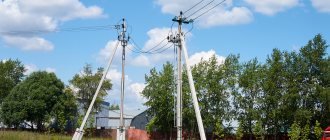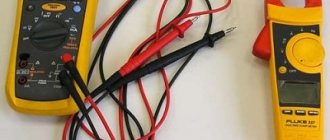Overhead lines are used to transmit electricity over long distances. This method is much cheaper than transportation via underground and overground lines. To reduce power losses, high voltage power transmission is used. Let's look at how to determine line voltage by external signs.
Electricity of the net. Rated voltages. Permissible deviations
The rated voltages of electrical networks, sources and receivers of electrical energy of direct and alternating current of industrial frequency are determined by a set of documents: GOST 23366, GOST 721, GOST 21128, GOST 6962 and GOST 29322.
Range of standard voltages
A number of standard voltages are established by GOST 23366 for direct and alternating current of industrial frequency. The voltage at the terminals of the designed equipment must correspond to the values of this series, with the exception of some cases [3, clause 2]. Below are the standard range of voltages for electrical energy consumers
[3, table 1] .
The main series of voltages of direct and alternating current of electric energy consumers is presented in Table 1, the auxiliary series of voltages of alternating current - in Table 2, and of direct current - in Table 3. Table 1 - Series of voltages of direct and alternating current of electric energy consumers
| No. | U, V | No. | U, V |
| 1 | 0,6 | 14 | 1140 |
| 2 | 1,2 | 15 | 3000 |
| 3 | 2,4 | 16 | 6000 |
| 4 | 6 | 17 | 10000 |
| 5 | 9 | 18 | 20000 |
| 6 | 12 | 19 | 35000 |
| 7 | 27 | 20 | 110000 |
| 8 | 40 | 21 | 220000 |
| 9 | 60 | 22 | 330000 |
| 10 | 110 | 23 | 500000 |
| 11 | 220 | 24 | 750000 |
| 12 | 380 | 25 | 1150000 |
| 13 | 660 |
Table 2 - Auxiliary range of AC voltages for electrical energy consumers
| No. | U, V |
| 1 | 1,5 |
| 2 | 5 |
| 3 | 15 |
| 4 | 24 |
| 5 | 36 |
| 6 | 80 |
| 7 | 2000 |
| 8 | 3500 |
| 9 | 15000 |
| 10 | 25000 |
| 11 | 150000 |
Table 3 - Auxiliary range of DC voltages for electrical energy consumers
| No. | U, V | No. | U, V | No. | U, V | No. | U, V |
| 1 | 0,25 | 11 | 24 | 21 | 300 | 31 | 5000 |
| 2 | 0,4 | 12 | 30 | 22 | 400 | 32 | 8000 |
| 3 | 4,5 | 13 | 36 | 23 | 440 | 33 | 12000 |
| 4 | 1,5 | 14 | 48 | 24 | 600 | 34 | 25000 |
| 5 | 2 | 15 | 54 | 25 | 800 | 35 | 30000 |
| 6 | 3 | 16 | 80 | 26 | 1000 | 36 | 40000 |
| 7 | 4 | 17 | 100 | 27 | 1500 | 37 | 50000 |
| 8 | 5 | 18 | 150 | 28 | 2000 | 38 | 60000 |
| 9 | 15 | 19 | 200 | 29 | 2500 | 39 | 100000 |
| 10 | 20 | 20 | 250 | 30 | 4000 | 40 | 150000 |
Standard range of voltages for sources and converters (for example: generator, transformer, etc.) of electrical energy
[3, table 2] . A number of voltages for alternating current are given in Table 4, for direct current - in Table 5.
Table 4 - Range of AC voltages of electrical energy sources and converters
| No. | U, V | No. | U, V |
| 1 | 6 | 15 | 10500 |
| 2 | 12 | 16 | 13800 |
| 3 | 28,5 | 17 | 15750 |
| 4 | 42 | 18 | 18000 |
| 5 | 62 | 19 | 20000 |
| 6 | 115 | 20 | 24000 |
| 7 | 120 | 21 | 27000 |
| 8 | 208 | 22 | 38500 |
| 9 | 230 | 23 | 121000 |
| 10 | 400 | 24 | 242000 |
| 11 | 690 | 25 | 347000 |
| 12 | 1200 | 26 | 525000 |
| 13 | 3150 | 27 | 787000 |
| 14 | 6300 | 28 | 1200000 |
Table 5 - Range of DC voltages of electrical energy sources and converters
| No. | U, V | No. | U, V |
| 1 | 4,5 | 8 | 230 |
| 2 | 6 | 9 | 460 |
| 3 | 12 | 10 | 600 |
| 4 | 28,5 | 11 | 1200 |
| 5 | 48 | 12 | 3300 |
| 6 | 62 | 13 | 6600 |
| 7 | 115 |
When choosing voltage, preference should be given to the main series.
Rated voltage of electrical equipment up to 1000 V
The rated voltage of equipment up to 1000 V is regulated by GOST 21128. A number of rated voltages are given in Table 6 [2, p.2].
Table 6 - Rated voltage of sources, converters, power supply systems, networks and receivers up to 1000 V
| Type and type of current | Rated voltage, V | |
| sources and converters | power supply systems, networks and receivers | |
| Constant | 6; 12; 28,5; 48; 62; 115; 230; 460 | 6; 12; 27; 48; 60; 110; 220(230); 440 |
| Variable: | ||
| single-phase | 6; 12; 28,5; 42; 62; 115; 230 | 6; 12; 27; 40; 60; 110; 220(230) |
| three-phase | 42; 62; 230; 400; 690 | 40; 60; 220(230); 380(400); 660(690); (1000) |
Note:
The voltage values for electrical networks are indicated in parentheses according to [6, table 1]
Rated voltage of electrical equipment over 1000 V
The rated voltage of electrical equipment over 1000 V is regulated by GOST 721. A number of rated voltages are given in Table 7 [1, p.3].
Table 7 - Nominal phase-to-phase voltages for networks with voltages above 1000 V
| Networks and receivers, kV | Generators and synchronous compensators, kV | Transformers and autotransformers without on-load tap-changer, kV | Transformers and autotransformers with on-load tap-changer, kV | Highest operating voltage of electrical equipment, kV | ||
| Primary windings | Secondary windings | Primary windings | Secondary windings | |||
| (6) | (6,3) | (6) and (6.3)* | (6.3) and (6.6) | (6) and (6.3)* | (6.3) and (6.6) | (7,2) |
| 10 | 10,5 | 10 and 10.5* | 10.5 and 11.0 | 10.0 and 10.5* | 10.5 and 11.0 | 12,0 |
| 20,0 | 21,0 | 20,0 | 22,0 | 20.0 and 21.0* | 22,0 | 24,0 |
| 35 | — | 35 | 38,5 | 35 and 36.75 | 38,5 | 40,5 |
| 110 | — | — | 121 | 110 and 115 | 115 and 121 | 126 |
| (150)* | — | — | (165) | (158) | (158) | (172) |
| 220 | — | — | 242 | 220 and 230 | 230 and 242 | 252 |
| 330 | — | 330 | 347 | 330 | 330 | 363 |
| 500 | — | 500 | 525 | 500 | — | 525 |
| 750 | — | 750 | 787 | 750 | — | 787 |
| 1150 | — | — | — | 1150 | — | 1200 |
Note:
1. The voltages indicated in brackets are not recommended for newly designed networks and electrical installations; 2. Voltages marked “*” for transformers and autotransformers connected directly to the generator voltage buses of power plants or to the generator terminals;
In the Russian Federation, two voltage systems (kV) have historically developed:
- 110 — 330 — 750
- 110 — 220 — 500 — 1150
The first voltage system (110 - 330 - 750) prevails in the western part of the Russian Federation, and the second (110 - 220 - 500 - 150) - in its eastern part. In the networks of the central part of the Russian Federation there is no obvious predominance of one voltage system over another; this is a kind of transition zone.
Rated voltage of traction systems (electrified transport)
The rated voltage for electrified transport is regulated by GOST 6962 and GOST 29322. Table 8 shows a number of rated voltages for traction substations and pantographs of electrified transport [4, page 3][6, table 2].
Table 8 - Rated voltages of traction substations and current collectors of electrified transport
| Type of electrified transport | Voltage, V | |||
| on the busbars of a traction substation | on the current collector of electrified transport | |||
| Railways | ||||
| Trunk: AC | (27500) | 25000 | ||
| direct current | (3300) | 3000 | ||
| Industrial: AC access and quarry tracks | (27500) | 25000 | ||
| access, quarry and in-plant DC tracks | (3300) (1650) (600) | 3000 1500 600 (550) | ||
| Urban electrified transport | ||||
| metro | (825) | 750 | ||
| tram, trolleybus | (600) | 600 (550) | ||
Note:
Voltage values are indicated in parentheses according to [4, page 3]
Permissible voltage deviations
In reality, during the operation of electrical networks, sources, converters and consumers of electrical energy, the voltage on them differs from the nominal parameters. This may be due to disruption of the normal operation of equipment, losses of electricity during transmission, etc. GOST 29322-2014 partially regulates the permissible voltage deviation values.
For electrical equipment with a voltage of 100 ÷ 1000 V, this range is limited to ±10% [6, table 1]. In other words, for a kettle designed for a rated voltage of 230 V, operation is allowed when the voltage increases up to 252 V and drops to 198 V. More details below, in Table 9 [6, Table A.1].
Table 9 - The highest and lowest voltages of sources and receivers of electrical energy with a voltage of 100 ÷ 1000 V inclusive
| Systems | Rated frequency, Hz | Voltage, V | |||
| Rated voltage of electricity sources and receivers | The highest voltage sources and receivers of electricity | Lowest voltage power sources | Lowest voltage of electricity receivers | ||
| Three-phase three-, four-wire systems | 50 | 230 | 253 | 207 | 198 |
| 230/400 | 253/440 | 207/360 | 198/344 | ||
| 400/690 | 440/759 | 360/621 | 344/593 | ||
| 1000 | 1100 | 900 | 860 | ||
| 60 | 120/208 | 132/229 | 108/187 | 103/179 | |
| 240 | 264 | 216 | 206 | ||
| 230/400 | 253/440 | 207/360 | 198/344 | ||
| 277/480 | 305/528 | 249/432 | 238/413 | ||
| 480 | 528 | 432 | 413 | ||
| 347/600 | 382/660 | 312/540 | 298/516 | ||
| 600 | 660 | 540 | 516 | ||
| Single-phase three-wire systems | 60 | 120/240 | 132/264 | 108/216 | 103/206 |
Permissible voltage deviations for traction systems (electrified transport) are given in table 10 (source - [6, table 2]).
Table 10 - Highest and lowest voltage of traction systems
| System type | frequency Hz | Voltage, V | ||
| Nominal | Greatest | Least | ||
| DC systems | — | 600* | 720* | 400* |
| 750 | 900 (975) | 500 (550) | ||
| 1500 | 1800 (1950) | 1000 (1100) | ||
| 3000 | 3600 (3850) | 2000 (2200) | ||
| Single-phase AC systems | 50 or 60 | 6250* | 6900* | 4750* |
| 16 2/3 | 15000 | 17250 | 12000 | |
| 50 or 60 | 25000 | 27500 (29000) | 19000 | |
Note:
1. Rated voltages marked “*” are not recommended for newly designed networks and electrical installations; 2. Voltage values are indicated in parentheses according to [4, p. 3]
For electrical equipment with a voltage of 1 ÷ 35 kV, GOST 29322-2014 establishes a permissible deviation of approximately ±10% [6, table 3].
Permissible voltage deviations for electrical equipment of 35 ÷ 230 kV are partially regulated by GOST 29322-2014, and for electrical equipment with voltages above 230 kV they are not regulated at all. But this, generally speaking, is the subject of a separate article.
Historical reference
The rated voltages of electrical networks, sources and receivers of electrical energy of direct and alternating current of industrial frequency until 1992 were determined by a set of documents GOST 23366, GOST 721, GOST 21128, GOST 6962. GOST 23366 established a number of standard voltages for electrical installations, GOST 21128 regulated the rated voltage in electrical installations up to 1000 V, for electrical installations over 1000 V - GOST 721, and GOST 6962 - rated voltages for urban electrified transport and railways.
In 1992, GOST 29322-92 “Standard Voltages” was published, which, according to the developers’ plan, was to be used in conjunction with GOST 721, GOST 21128, GOST 23366 and GOST 6962 [5, p. 1]. At its core, GOST 29322, being a document prepared by the direct application of the international standard IEC 38-83 [5, p.6], was intended to eradicate historically and territorially established nominal voltages and bring them to the “European” standard. Ultimately, GOST 29332 was supposed to replace the set of documents GOST 721/21128/23366/6962.
The second edition of GOST 29332 was published in 2014. This time, GOST 29332-2014 was compiled using the “translation method” of the IEC 60038:2009 standard and was no longer based on GOST 721/21128/23366/6962, although the latter have not lost their legal force.
Source
750-1150 kV
Ultra-high voltage overhead lines. The scope of application of such power lines from 750 to 1150 kV is similar to ultra-high voltage overhead lines.
Ultra-high voltage lines are pulled on U or V-shaped steel supports. They have from 4 to 8 wires per phase and from 20 insulators on a hanging garland.
The Energopostavshik company provides design, construction and reconstruction services for power lines up to 35 kV. We also accept orders for the supply of traverses for insulators and other metal structures for low-voltage and high-voltage lines of various classes. Call!
Classification of electrical networks for voltage classes
Voltage classes are classified as follows:
- depending on the area of application and purpose;
- according to the scale characteristics and dimensions of the network;
- by type of current.
According to the first point, there are networks:
- General purpose (electricity supply in household, industrial, agricultural and transport formats).
- Autonomous power supply (for mobile and autonomous objects, such as ships, spacecraft, etc.).
- Technological facilities (for production facilities, as well as other utility networks).
- Contact (for the purpose of transmitting electricity to vehicles, for example, locomotives or trams).
According to the second point, networks are:
- Trunk (for connecting individual regions with consumption centers, characterized by high and ultra-high voltage levels, as well as large power flows).
- Regional (powered by main networks and focused on servicing a large consumer (city, region, etc.), characterized by medium and high voltage levels, with large power flows).
- District (power is supplied from regional networks, they usually do not have their own power supplies, are focused on serving small and medium-sized consumers), are characterized by low and medium voltage levels, as well as insignificant power flows;
- Internal (their task is to distribute electricity in small spaces (within a city or a single area), sometimes have their own (backup) power source, are characterized by insignificant power flows and low voltage levels).
- The lowest level networks (electrical wiring) power a separate building, workshop or room; we are talking about small power flows and low (household) voltage levels.
According to the third point, the current happens:
- three-phase alternating (current is transmitted through three wires with a phase shift of the alternating current in each of them by 120 degrees relative to the others), each wire in it is considered a phase with a certain voltage, acting as the 4th conductor;
- single-phase alternating (current is transmitted through two wires due to household electrical wiring from a substation or distribution board);
- direct current (for some autonomous power supply networks and a number of special ultra-high voltage networks).
The power of three-phase alternating current is expressed by the formulas:
$P=\sqrt{3}UI\cos{\varphi}$ (active);
$Q= \sqrt{3}UI\sin{\varphi}$ (reactive);
$S=\sqrt{3}UI=\sqrt{P^2+Q^2}$.
Where $U$ and $I$ are the linear voltage and current, respectively, and $\varphi$ is the phase shift angle between the voltage and current vectors for the same phases.
6-10 kV
Middle class. Used to transport electricity to transformer substations that supply end consumers. The overhead line voltage ranges from 6-10 kV to 35 kV.
6-10 kV lines are built to transport electricity over short distances. Moreover, in urban conditions, overhead lines with a voltage of 6 kV are used, in rural areas - 10 kV. The lines are distinguished by the presence of high reinforced concrete supports and more massive pin insulators made of porcelain or glass. The wires are fixed on the rotary posts with hanging garlands of 2-3 insulators.
Medium voltage lines have 3 wires. Often, 0.4 and 10 kW power lines are pulled on the same racks. In this case, current-carrying lines of higher voltage are placed on wide cross-arms at the top of the support. The 4-wire 0.4 kV line is located below.










